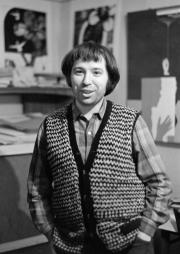
Victor Pivovarov graduated from the Kalinin Industrial Art School (1951-1957) and the book illustration department of the Moscow Polygraphic Institute (1957-1962). He devoted several years to illustration, primarily of children’s books. He gained a reputation as one of the best children’s illustrations, and designed the magazines Veselye kartinki and Murzilka, which had subscriptions in the millions. He began working in easel drawing in 1967 and easel painting in 1980.
Pivovarov’s studio was not far from Kabakov’s on Sretensky Boulevard, and the two artists were friends. Not far were the studio of other artists, of Erik Bulatov and Oleg Vassiliev, Ülo Sooster (who shared with Kabakov), Ernst Neizvestny, Vladimir Yankilevsky, and Yuri Sobolev-Nolev. All these artists met frequently and discussed their works. This allowed some researchers to introduce the concept of the “Sretensky Boulevard Group” that led to the formation of the Moscow Conceptualist School.
In 1982, Pivovarov emigrated to Prague, where he now lives. He has written books about the art of the 1960s-1980s in Moscow: “Agent in Love” and “Gray Notebooks.” The first major retrospective of Pivovarov was held at the Tretyakov Gallery in Moscow in 2004, followed by one at the State Russian Museum in St. Petersburg. His works are in the collections of the Tretyakov Gallery, the State Pushkin Museum in Moscow, and the Russian Museum in St. Petersburg.
Along with Kabakov, Pivovarov is considered one of the founders of Moscow Conceptualism. Following Kabakov, he discovered the album genre, which combines image and text. Since 1975, he has produced more than thirty albums. In the early 1970s, he created a series of painting in nitro enamel under the influence of stands at railroad stations, in which he saw absurdity and surrealism. In painting, Pivovarov prefers thematically related conceptual cycles and series of pictures. For example, “Projects for a Lonely Man” (1975), “Seven Conversations” (1976), “Diary of an Adolescent” (1988), and “Apartment 22.” Unlike the other artists of his circle, Pivovarov does not address social issues, for his works are a rarified dialogue with other artists, writers he illustrates, and masters of the past. Many cycles are infused with autobiographical and Surrealistic elements, dreams, and Dadaist absurdity, imbued with irony and the self-irony of mystification.